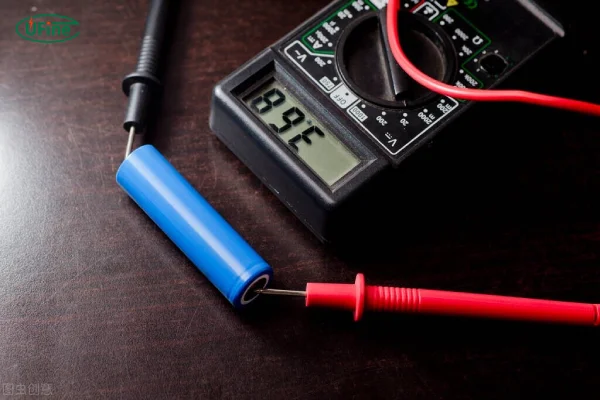Part 1. What is battery voltage?
At its most basic, battery voltage is a measure of the electrical potential difference between the two terminals of a battery—the positive terminal and the negative terminal. It’s this difference that pushes the flow of electrons through a circuit, enabling the battery to power your devices.
Think of it like water in a pipe: the higher the pressure (voltage), the more water (electrons) can flow. But just like too much water pressure can burst a pipe, too much voltage can damage your device. So, finding the right voltage balance is crucial.
Voltage is vital because it dictates how much power the battery can deliver to the device. However, a battery’s voltage is not static. It changes during both charging and discharging cycles, and this fluctuation can have a significant impact on your device’s performance.
Part 2. What determines battery voltage?
Understanding what determines battery voltage is key to knowing how batteries function. A battery’s voltage is influenced by a variety of factors:
-
Chemical Composition: The chemistry of a battery dictates its voltage. For example, lithium-ion batteries (which are used in most modern smartphones and laptops) have a nominal voltage of 3.7V per cell, while alkaline batteries typically have 1.5V.
-
Number of Cells: Most batteries, especially rechargeable ones, are composed of multiple cells connected in series. Each cell contributes to the overall voltage. For example, a 12V lead-acid battery typically consists of six 2V cells connected together.
-
State of Charge (SOC): A fully charged battery will have a higher voltage than a battery that’s running low. When you charge a battery, the voltage gradually increases until it reaches a safe maximum level.
-
Temperature: Temperature can also play a role in battery voltage. Cold temperatures can cause the voltage to drop, while excessive heat can cause temporary voltage spikes. This is why batteries sometimes seem to perform poorly in extreme weather conditions.
-
Internal Resistance: As a battery ages, its internal resistance increases, which can affect the voltage under load. This is one reason why older batteries tend to deliver lower voltages than newer ones.
Part 3. Various types of voltage
There are several types of voltage to consider when discussing battery performance. Each type has its own function and significance:
-
Nominal Voltage: This is the average or standard voltage a battery provides during typical use. It’s the most common voltage rating you’ll see when shopping for batteries. For example, a lithium-ion battery has a nominal voltage of 3.7V.
-
Open Circuit Voltage (OCV): This refers to the voltage of a battery when it is not connected to a load (i.e., when no current is being drawn from it). This is often used to measure the “resting” voltage of a battery.
-
Load Voltage: This is the voltage a battery delivers when it is powering a device or under load. It tends to be lower than the OCV because the battery’s internal resistance causes some energy loss.
-
Charging Voltage: When you recharge a battery, the charging voltage is the amount of voltage applied to push current back into the battery. This voltage is typically higher than the nominal voltage to ensure the battery reaches a full charge.
-
Cut-off Voltage: The cut-off voltage is the minimum voltage a battery can safely discharge to before it’s considered empty. For most lithium-ion batteries, this is typically around 3.0V per cell. Going below this voltage can damage the battery.
-
Float Voltage: This is the voltage maintained in a battery during long-term storage, often used for backup power systems. It’s lower than the charging voltage but enough to keep the battery at full charge.
-
Maximum Voltage: This refers to the highest voltage a battery can reach during charging before it risks overcharging and damage.
Part 4. Voltage of common battery types
Different battery types have different voltage levels. Here’s a breakdown of the nominal voltages for some of the most commonly used batteries:
- Lithium-Ion (Li-ion): 3.7V per cell
- Nickel-Cadmium (NiCd): 1.2V per cell
- Nickel-Metal Hydride (NiMH): 1.2V per cell
- Alkaline: 1.5V per cell
- Lead-Acid: 2V per cell
- Lithium-Polymer (Li-Po): 3.7V per cell
- Zinc-Carbon: 1.5V per cell
Each type of battery is designed to provide a specific voltage to meet the needs of different devices, so choosing the right battery is critical for proper functionality.
Part 5. Does the battery voltage change?
Yes, the battery voltage changes throughout its lifecycle, most notably during charging and discharging.
-
During Discharge: As a battery discharges, its voltage gradually decreases. For example, a lithium-ion battery will drop from around 4.2V (fully charged) down to 3.7V, then further to 3.0V (cut-off voltage), after which the device will stop working.
-
During Charging: When charging, the battery voltage increases. For lithium-ion batteries, the charging voltage typically starts around 4.2V per cell. However, it is important to note that charging should never exceed the maximum safe voltage specified for the battery type, as this can lead to overheating and permanent damage.
-
Temperature Effects: Battery voltage can also change due to environmental factors. For example, in cold weather, battery voltage can temporarily drop, affecting performance.
Understanding Lithium Battery Charge-Discharge Curves
Part 6. How voltage changes affect lithium battery performance

1. The Relationship Between Voltage and Capacity
Generally, a battery’s capacity is directly proportional to its voltage. As the voltage increases, the capacity also increases, allowing the battery to store more energy. This is why lithium-ion batteries with higher voltage typically offer longer usage times.
2. The Relationship Between Voltage and Discharge Curve
The discharge curve shows how the voltage of a lithium-ion battery changes over time during use. Different voltages affect the shape and slope of the discharge curve. Typically, the discharge curve of a lithium-ion battery exhibits a steady decline. However, with varying voltages, the shape and rate of decline of the curve can differ. This is important for ensuring proper device operation and for accurate battery life displays.
3. The Relationship Between Voltage and Charging/Discharging Speed
Lithium-ion batteries with higher voltage can charge and discharge faster. This means that using a high-voltage lithium battery allows you to charge devices more quickly and use them for a longer period. However, excessively high voltage can cause the battery to overheat and get damaged. Therefore, balance must be considered in both design and usage.
4. The Relationship Between Voltage and Safety
Overcharging and over-discharging lithium-ion batteries can compromise their safety, sometimes leading to fires or other serious accidents. The voltage limits of a battery are a key consideration when designing charging circuits to ensure safe operation. If a battery’s voltage exceeds the normal range, it may trigger the battery’s protection mechanisms, such as power cutoffs or short-circuit protection, to prevent damage or safety hazards.
5. Other Effects of Voltage Changes
Lithium-ion batteries that remain at low voltage for extended periods may experience accelerated harmful chemical reactions inside the battery, such as electrolyte decomposition or the shedding of active materials. These processes lead to irreversible capacity loss.
Low voltage can also cause microscopic structural changes inside the battery, such as uneven expansion and contraction of the electrode materials. These issues can further accelerate aging and performance degradation.
Part 7. The impact of voltage instability on electronic devices
Voltage instability—whether caused by overcharging, undercharging, or fluctuations in temperature—can have serious consequences on your devices:
- Performance Issues: A drop in voltage can cause your device to malfunction, freeze, or shut down unexpectedly. For instance, smartphones and laptops may not perform at their best if the voltage is too low, causing lagging or erratic behavior.
- Overheating and Damage: Excessive voltage can lead to overheating, which is particularly dangerous for lithium-ion batteries. Prolonged exposure to high voltage can cause the battery to swell, leak, or even catch fire.
- Shortened Battery Life: Consistent voltage instability leads to faster degradation of battery health, reducing its overall lifespan.
- Data Corruption: In sensitive electronics like laptops or cameras, voltage drops can cause data loss or file corruption, especially if the device suddenly powers off during operation.
Part 8. Consistency of lithium battery voltage
The consistency of voltage in lithium batteries refers to the ability of individual cells within the same batch or system to maintain the same terminal voltage under identical conditions. Voltage consistency is crucial for the overall performance, lifespan, and safety of lithium battery packs.
Effects of Voltage Inconsistency on Lithium Batteries
-
Reduced Performance
Voltage differences between cells can lead to decreased overall performance of the battery pack. During discharge, cells with lower voltage will limit the overall discharge voltage and capacity of the pack, reducing the total energy output. -
Imbalanced Charging and Discharging
Voltage inconsistency can cause imbalance during charging and discharging. Some cells might reach full charge or discharge sooner, while others may not reach their limits. This leads to a lower overall capacity utilization of the battery pack. -
Risk of Thermal Runaway
Voltage inconsistency may increase the risk of thermal runaway in the battery pack. Overcharged or over-discharged cells can generate excessive heat, and if this heat isn’t dissipated quickly, it may cause the battery to overheat and potentially lead to dangerous safety incidents. -
Reduced Lifespan
Voltage inconsistency can cause greater differences in the lifespan of individual cells. Some cells may fail prematurely due to excessive charging or discharging, which ultimately shortens the lifespan of the entire battery pack.
Part 9. How to measure battery voltage?
Measuring battery voltage is an easy process if you have the right tools. Here are a few methods:
- Using a Multimeter: A digital multimeter can quickly measure the voltage of a battery. Simply connect the multimeter probes to the battery terminals, and it will show you the current voltage.
- Battery Testers: Battery testers are specially designed to measure the voltage and health of batteries. They’re a bit more user-friendly than a multimeter and are great for checking the condition of disposable and rechargeable batteries.
- Built-In Battery Management Systems (BMS): Many modern devices and rechargeable batteries come with integrated BMS that automatically monitor the voltage, temperature, and health of the battery to ensure safe operation.
Part 10. Is the higher the battery voltage, the better?
This is a common question. While higher voltage can deliver more power, it’s not suitable for all applications:
Advantages:
- More power for high-demand devices.
- Greater energy efficiency in some systems.
Disadvantages:
- Increased risk of overheating and damage if the device isn’t designed for high voltage.
- Higher costs for batteries and associated safety measures.
Related Tags:
More Articles

How to Choose the Best Floor Scrubber Battery for Commercial Cleaning?
Selecting the ideal floor scrubber battery ensures a long runtime, rapid charging, and minimal maintenance for efficient commercial cleaning operations.
Battery for Blower vs Battery for Leaf Vacuum: Which One Should You Choose?
Battery for blower vs leaf vacuum—learn the key differences in power, fit, and runtime to choose the right battery for your outdoor tool needs.
How to Choose the Right Battery for Blower?
Choosing the right blower battery? Consider voltage, capacity, chemistry & usage. This guide helps match the best battery for peak performance.
How to Choose the Best Insulated Battery Box for Lithium Batteries?
Choosing the Best Insulated Battery Box for Lithium Batteries? Discover key factors such as size, material, and safety for optimal protection and performance.
7 Critical Elements on a Lithium Battery Shipping Label
What must be on a lithium battery shipping label? Learn 7 key elements to ensure safety, legal compliance, and correct handling across all transport modes.




